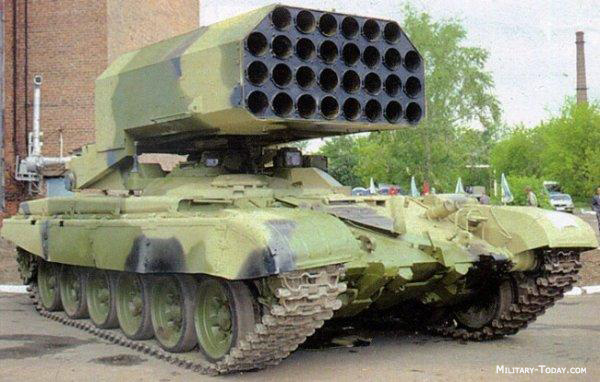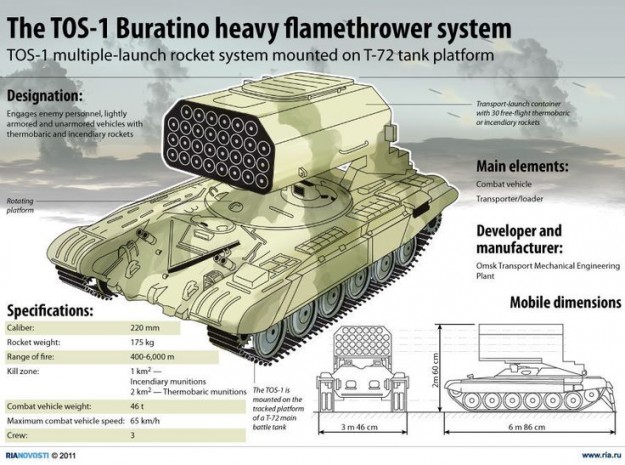I follow world geopolitics pretty intensely. I credit epic, political space opera settings like Dune and, of course, BattleTech for my many years of interest. I was browsing some of the latest Russian shenanigans in Ukraine and Syria when I saw a Russian armored vehicle that made me wonder if they’ve been buying from Quickscell.
The TOS-1 Buratino really is a mobile warcrime waiting to happen, as it uses only incendiary and thermobaric 220mm munitions in the 30-tube launch system. The rockets have a minimum range of 400 meters and a maximum effective range of 3.5km. Short enough of a range that the system and crew are quite protected by the armored chassis of a T-72 MBT. Well armored by artillery standards anyway. This video shows that they can expend their loadout very quickly:

Be afraid, mechwarrior. Be VERY afraid.
Russia has been avid fans of rocket-based artillery systems in multiple range classes from the short ranged Grad all the way up to (potentially nuclear) Short Range Ballistic Missiles like the FROG and Scarab since the Second World War. But what sets the Buratino apart are its literal firefighting abilities. The incendiary munition contains several dozen submunitions that scatter a highly flammable gel above a target area. Imagine an inferno-based FASCAM or Arrow IV cluster munition ruleset. I can’t think of many MechWarriors that could unsee that mental image.
The real workhorse munition is thermobaric. Taken from the Greek words for “heat” and “pressure”, thermobaric weapons use an aerosolized fuel and air mix to create an extremely powerful and very long duration concussive blast wave matched only by nuclear weapons. In fact, they have been known as the ‘poor man’s atomic bomb’ since their advent decades ago. They recently came back into popular use, especially in the Russian military as a means to crush reinforced bunkers, pulverize buildings and neighborhoods, and even suffocate and incinerate troops taking refuge in deep caves. The Russian military absolutely loves their thermobaric weapons. They even developed a repeating grenade launcher for infantry use.

I could have sworn I’ve stepped on millions of these in MechWarrior IV.
A 2000 U.S. Defense Intelligence Agency study of thermobaric weapons said:
“The [blast] kill mechanism against living targets is unique–and unpleasant…. What kills is the pressure wave, and more importantly, the subsequent rarefaction [vacuum], which ruptures the lungs…. If the fuel deflagrates but does not detonate, victims will be severely burned and will probably also inhale the burning fuel. Since the most common FAE fuels, ethylene oxide and propylene oxide, are highly toxic, undetonated FAE should prove as lethal to personnel caught within the cloud as most chemical agents.”
So even if it doesn’t kill you, it kills you. Who came up with this, Stephan Amaris?
The western military dogma is all about precision. Electronic this, GPS or laser-guided that. The U.S., for example, gave up their Fuel Air Explosives not long after Vietnam, while Russia is perfectly fine with simple effectiveness with little regard for peripheral damage and casualties even today. Weapons like the Buratino really showcase the differences in the two schools of thought on the art of war.
Whether in the 20th century, or the 31st.
Well bargained, and medium-well done.
Actually, the US famously used FAE munitions in Afghanistan this century to more easily kill troops (and any civilians too) hiding in caves by utilitizing the “rarefaction” properties of such munitions to suck the oxygen out of those caves, burst lungs and other vital organs, etc. Anyone who thinks this is “cool” needs to remember this is happening to fellow human beings and not super evil henchmen out of some comic book movie.
http://www.iacenter.org/folder04/nowar_truth.htm
Absolutely it’s a different story on the hex map. No ‘cool’ factor intended- just finding some parallels between real life technology and that of the game. I would think a Thermobaric ban would be retconned into the Area Convention if they were more well known.
Interesting read. What’s also interesting is how we look at these things now as compared to 60 years ago. Our bombers used to firebomb tokyo in WWII. In those days many of their buildings were wood and the fire bombs would create more casualties than the atomic bombs we dropped. Nobody really talked about how horrific that was back then.
And the big reason is what you are using right now. Instant and widespread electronic media. In world war 2, the most people ever saw were the heavily censored war photographs and newsreel footage preceeding the matinee. Vietnam was a real watershed technologically and culturally.
Journalists weren’t so inclined to jump in bed with the establishment anymore, and a nightly diet of news footage of burning villages helped to cement war as something much more than simple patriotism and personal honor.
Playing war inspired games like BattleTech has always been used as a kind of romanticized, sterilized means to express interest in endeavors in which NO ONE truly wants to take part. I just make occasional posts like this as kind of a reminder that these toys DO have analogues that inflict real world consequences- however cool they are.
I honestly feel that all the focus on being “more humane” and basically handicapping the military’s ability to do its job creates more damage than it prevents, as it serves to prolong the conflict. As much as I don’t agree with Russia’s politics and diplomacy, their means of carrying it out is simple, efficient, and effective, much more so than Western powers, where the military is at the mercy of their government rather than having the backing and support of it.
https://www.youtube.com/watch?v=SvI3fosJyv0
Hello, Ron. This is UA community person speaking. Would you mind taking this down? Article very much not appreciated, thanks.